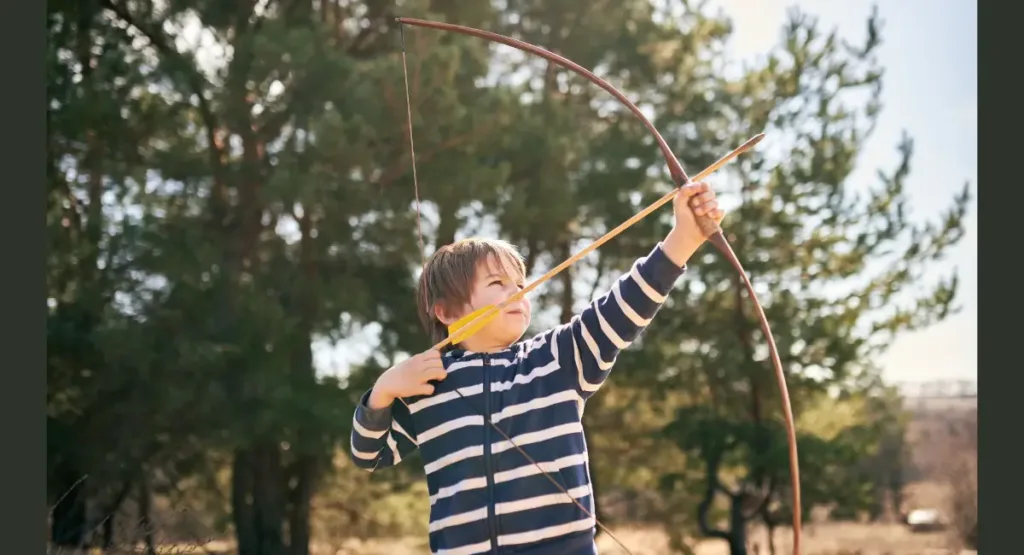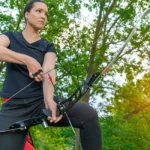Longbows, with their evocative string pull, arrow quiver, and the air’s whoosh along their trajectory, have stood as symbols of archery’s elegance and effectiveness for centuries. But what’s the true shooting range? Read our blog post for insights into the physical limits of longbow shooting. We explore historical, technological, and human aspects contributing to the arrow’s ultimate distance.
Embracing Longbow Grace
The longbow’s historical significance is deeply intertwined with human history, symbolizing triumph and tradition. From Agincourt’s ancient battles to Robin Hood’s legendary tales in Sherwood Forest, the longbow’s simple yet elegant design contrasts sharply with modern weaponry. This captivating weapon fascinates archery enthusiasts and outdoor adventurers alike.
Exploring historical records reveals the remarkable archery feats of the past that continue to resonate through time. Despite the allure of these tales, archers often ponder a practical question – what is the true range of a longbow?
Exploring Longbows: A Deep Dive into Their Design
To address this inquiry, we need to first analyze the longbow structure and grasp the key principles that influence its shooting range. Longbows, as their name suggests, exceed traditional recurve or compound bows, reaching almost 6 feet. This extended length results in stored potential energy, which transforms into kinetic energy upon arrow release.
The bow design
Longbows feature a ‘simple’ design; however, simplicity should not be mistaken for inefficiency. The unassuming D-shape of an unstrung longbow masks its remarkable capacity to store energy, yielding substantial potential energy that, once transferred to the arrow, propels it forward with considerable force.
Draw Weight and Material Construction
- Draw weight significantly impacts arrow distance.
- Higher draw weight = more stored energy = increased power upon release.
- Traditional longbows: 80-100 pounds; war bows: over 150 pounds.
- Bow material matters: longbows crafted from yew or elm, known for flexibility and strength.
Historical Background: The Battlefield and Beyond
During their prime, longbows were synonymous with military power, especially evident in the Hundred Years’ War between England and France. The Battle of Agincourt showcased the longbow’s precision at long range and its significant impact on enemy troops. In hunting scenarios, the longbow expanded archers’ shooting distance, enabling them to hunt game at previously challenging ranges with shorter bows.
The Use of Longbows in Warfare
English archers played a crucial role in many battles, particularly those on France’s expansive fields. The speed and power of the longbow gave English forces a significant advantage, serving as a potent weapon against advancing foes. Historical accounts suggest that longbow shots penetrate armor, underscoring its effectiveness at long distances.
Historical Accounts of Long-Distance Shooting
During the Siege of Sancerre in 1572, a legendary longbow shot hit a man from 600 meters. These history tales enrich the historical narrative but also spark curiosity and inspiration among modern archers.
Modern Longbow Performance and Comparisons
The tradition of longbow shooting remains a vibrant living art upheld globally. While the longbow’s range may seem more limited than modern bow types like compound and recurve, its allure lies in embodying the essence of skillful, traditional archery. This is rather than surpassing contemporary bows.
Technological advancements
Despite traditional crafting methods, modern archers benefit from technological advancements that improve longbow performance. Synthetic materials can now be utilized to construct more durable bows with consistent performance. Additionally, laminated bows, which layer different materials, can provide a balance between tradition and modularity.
Archer skill and design.
Archer expertise is crucial in longbow shooting. Precision in aiming, drawing, and releasing the arrow is refined through extensive practice. Furthermore, the arrow and string design can impact the shot’s trajectory and distance. A well-crafted arrow, properly fletched and balanced, ensures accurate flight over long distances.
Real-Life Instances of Impressive Longbow Shoot
Modern archery has made notable accomplishments in longbow shooting distances. Archers who have pushed boundaries serve as compelling examples of the potential achievable with a longbow in skilled hands.
Long-range shooting feats
In 2006, an archer accomplished an impressive longbow shot covering nearly 900 meters, demonstrating how longbows have been capable of covering remarkable distances. These achievements showcase the archer’s skill and bow power.
List of Notable Longbow Archers and Their Achievements
The field of longbow shooting boasts renowned figures like Byron Ferguson, acclaimed for his impressive long-range shooting displays, and Linda Howell, a record-holder for long-range shooting with longbow. Their commitment to the art and unwavering pursuit of accuracy exemplify the longbow’s limitless capabilities.
Practical Guidelines for Archers’ Long-Distance Shooting
For those who seek to improve their longbow shooting distance, there are practical steps to consider. From gear selection to personal fitness, enhancing your longbow shooting distance is a multifaceted endeavor that requires dedication and methodical practice.
Selecting the Right Equipment
Optimizing the longbow for maximum distance shooting requires precise selection of the bow’s draw weight, the arrow’s weight, and the archer’s draw length. These factors must harmonize to produce optimal propulsive force. Furthermore, adjusting the bow’s brace height can affect arrow speed and shooting distance.
Training and practice
Training and practice form the foundation of archery proficiency. Longbow shooters need consistent form and technique for repeatable, accurate shots. Additionally, integrating strength training and exercises targeting archery muscles can enhance draw weight and shooting endurance.
Final Words : Exploring Limits and Unleashing Maximum Potential
Longbows tribute the ancient art of archery, blending nostalgia with practicality. For enthusiasts, the question ‘how far’ delves beyond distance, encompassing the rich history and human accomplishments propelled by an arrow from a longbow.
In essence, examining the reach of a longbow transcends mere figures; it involves a detailed analysis of various elements, from the bow itself to the archer’s expertise, converging on each shot taken. It takes an archer’s creativity and perseverance to realize the longbow’s potential to hit far by grasping these fundamentals and embracing challenges.
Read More







